
General Idea: Broken Time
Museo Jumex
Miguel de Cervantes Saavedra 303, Colonia Granada, Ciudad de México, D.F.
What’s On View: A retrospective of the Canadian Collective, General Idea (comprised of artists AA Bronson, Felix Partz, and Jorge Zontal.) A collection of works spanning two floors of the museum arranged semi-chronologically from their 25-year-long career in a vast array of formats including installations, video art, painting, publications, and performance.

Installation View
Molly: It’s magical when an artist collective syncs so well that their daily performance grows into a personal mythology, especially one that spans such an extensive length of time. I feel like I hit every point on my emotional spectrum walking through the retrospective (I should probably forewarn that I am a General Idea super fan.) General Idea strove to create create humorous, political, and poignant work together, even in times of illness and crisis. The world seems so bleak lately that I feel like I need to run 1 mile, go to yoga class, and take a shot of tequila just to prepare myself to read the news each day. Walking through the exhibition I felt inspirited in a way I feel like I haven’t since the inauguration.
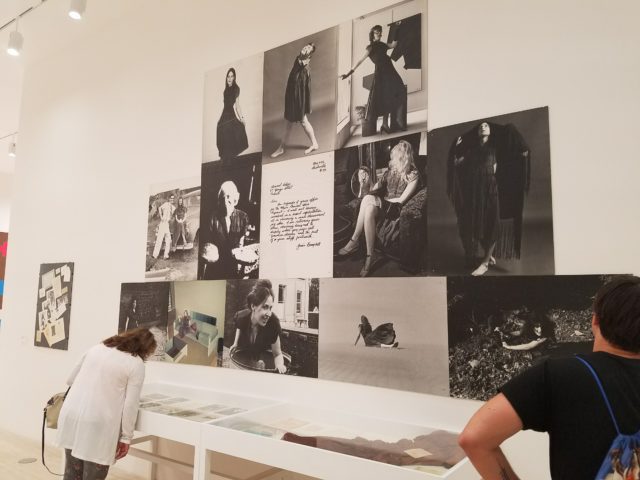
Documentation of the 1971 Miss General Idea Pageant.
Michael: I had a similar thought while we were there: this is the exhibition so many artists in our generation need to see right now. Over the past few months, there’s been all this self-doubt about the role of artists in times of crisis and whether or not an “art practice” is worthwhile.
It’s beyond inspirational to see that General Idea (known for their AIDS art-activism) spent the decades before the epidemic throwing absurd drag beauty pageants, painting dogs fucking, doing wacky Yoko Ono-esque text pieces, and generally having weirdo fun. When the time came to mobilize for a cause, they had all these creative experiences, strategies, and vocabulary from years of experimenting. That’s not to say organizing for an absurdist artwork is important just as “practice” for mobilizing for a political cause—I think they were complementary processes, vital in different, overlapping ways. Never have I left an exhibition with such a strong urge to make weird “objective-less” art again, confident that it wouldn’t be contrary to something “productive”.
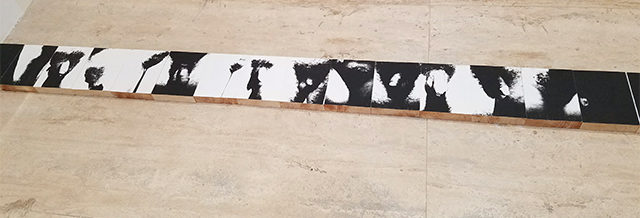
“Friends – A Preliminary Series (Xerox),” 1970.
One of the first pieces we saw, for example, was “Friends – A Preliminary Series (Xerox)” from 1970, which comprises a bunch of xerox prints of friends’ penises (as if they had laid on top of a flatbed copy machine) affixed to blocks on the floor like a minimalist installation. Something about it seems so obvious, but it’s so good. The piece is just so perfect and wrong for the time in which it was made—in the heyday of squares-on-the-floor minimalism, nearly a decade after Warhol’s “Thirteen Most Wanted Men” and nearly a decade before punk hit the art world in earnest. And yet it was clearly so personal too.

“Mondo Cane Kama Sutra,” 1984.
Molly: The sheer amount of work included in the show makes it incredibly personal— almost like you are experiencing it with them. Midway through we entered a room with a series of large paintings depicting pink, orange, and yellow poodles having threesomes in various positions. In the middle of the room there were two videos displayed, “Shut the Fuck Up Part I & II.” I think I have watched “Shut the Fuck Up Part II” about ten times since we have left the show. It’s a humorous illustration of how often artists, especially queer, can feel almost forced to create extravagant persona’s for the benefit of others. In the video General Idea members and friends perform a choreographed ballet in zentai suits of various dog breeds, making a mockery of the pampered dog’s “instinct to please.” After the dance members of General Idea, dressed the multicolor poodles in their paintings displayed on the walls of the museum, discuss the media’s insistence that the artist must “live to please and please to live.” The poodle stating “Even if you’re not in drag they always find a way to dress you up” was a clever mockery on the media’s need to make a spectacle of artists.
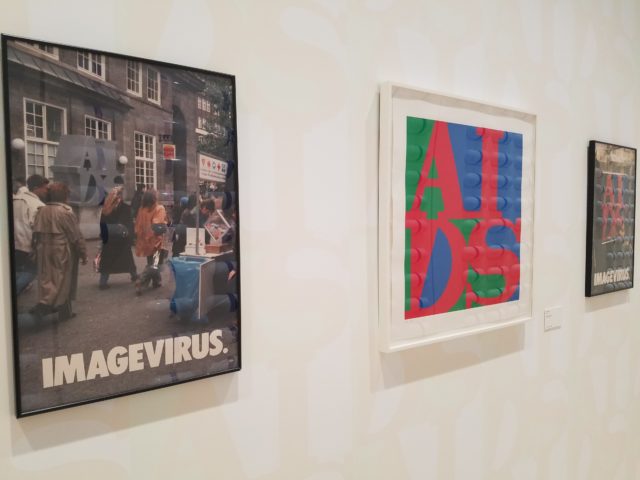
“Imagevirus Series,” 1989-1991.
In contrast, the final two rooms that directly addressed the AIDS crisis were heartbreaking, especially knowing Partz and Zontal were diagnosed at the time the work was made and eventually passed in 1994. The first room was a collection of reproduced photo albums that once belonged to a man who died from AIDS- related complications in Venezuela in 1988, titled “Maracaibo”. The pictures displayed various nude lovers, mostly soldiers, from various ethnicities and classes. The final room was a series of paintings, mimicking Robert Indiana’s original “LOVE” works from the 1960’s. Robert Indiana’s original work was serialized and reproduced in almost every fashion imaginable, shotglasses, keychains, dinner plates, etc. The logo permeated through culture almost like a virus. General Idea’s hope was mirroring Indiana’s original design the logo would “play a part of the virus itself” and create widespread awareness. The final display was four human sized AZT capsules next to wall lined with miniature versions of the pill. When you first walk into the exhibition you can see the coffin-like AZT tablets in the distance to the left but I was not prepared for the emotional weight they would carry after feeling like I had a walk through of the artist’s lives.
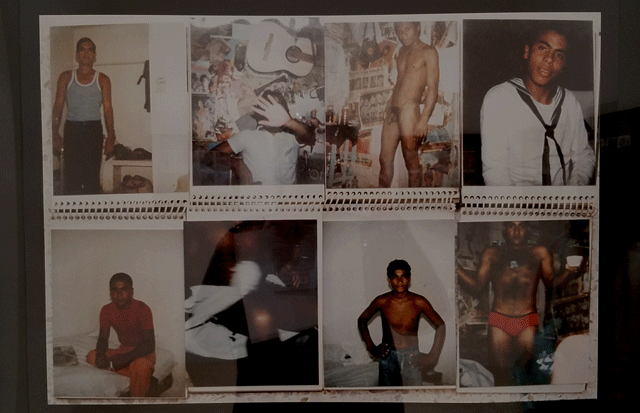
“Maracaibo,” copies of a found photo album, 1988.
Michael: I’m still not sure how I feel about that piece “Maracaibo”. It’s obviously this personal fetishistic collection, but the obsessiveness of it, when reproduced and contextualized like this, evokes the pseudo-scientific mythology of “patient zero” in the epidemic, as if its a specimen in the study of promiscuity or something. It’s further complicated by the accompanying text, which lists and explains an absurd variety of archaic Latin American racial classifications, each based on the percentages of European/Indigenous/African ancestry a person had.
But I think what really sets this retrospective apart from other General Idea exhibitions I’ve seen is the focus on the time the artists spent living rather than dying. I’m thinking specifically of a show I saw at the Warhol Museum way back in 2005. I know that’s a long time ago, and my memory is hazy, but I pretty much exclusively remember their AIDS-related work from that exhibition. That’s not a criticism, obviously, but seeing the cheeky joie de vivre in everything GI did before the epidemic made the emotional impact of their later work so much more potent.

“Artist’s Conception: Miss General Idea 1971”
Molly: I also have never seen such a focus on General Idea’s early work, which toys with glamour and sexuality in a simultaneously frivolous and thoughtful manner. I was especially excited to see the wall of different artist’s embodying Miss General Idea. Miss General Idea was a part of the collective’s mythology who weaved her way through various projects throughout their career but I believe the “Miss General Idea Pageant” in 1971 was her first appearance. The Miss General Idea Pageant was a faux beauty pageant where sixteen artists were mailed entry kits containing pageant rules and a basic brown dress. The thirteen artists who applied were to take photos embodying “Miss General Idea” in the provided dress. She was their ultimate beauty queen and blank canvas. I like to think of Miss General idea as a spectacle that artist’s could project their perceptions and parodies of glamour and queerness onto. I loved the choice to surround all the different incarnations of Miss General Idea, both male and female artists, around a blown up letter from an artist who clearly was lost on the humor in the project, calling it a “chauvinist pig idea.”

“Reconstructing Futures,” 1977.
Michael: Confession: I totally bought the “Miss General Idea” drag queen tote bag in the gift shop with the intention of making a back patch for a studded vest. Hands-down one of my favorite of their strange 1970s projects/happenings. I’m so into how well these sort-of ephemeral art events and interventions translated to documentation that felt like special artworks unto themselves. Everything lives on as posters, handwritten note cards, down to photos of an “installation” that consisted of reflecting light onto various walls. Probably the wildest documentation and recycling of imagery I’ve seen—1977’s “Reconstructing Futures”, in which they burned the then-futuristic “1984 Miss General Idea Pavillion”, a ziggurat containing ephemera from the pageants, and presented the ruins as an installation.

“fin de siècle,” 1990.
Molly: Walking out of the museum we passed a massive installation of glacial structures with three little seal stuffed animals placed in the corner. I honestly didn’t realize it was a part of the show until we left but it makes perfect sense that it was self portraiture. Throughout their career General Idea took portraits embodying the same characters, always just the three of them, whether it be the goth night school graduates, sexy babies, doctors, or poodles, parodying archetypes in a playful yet sardonic manner. The seal installation was playful and cute (Michael can vouch, I was squealing) but after reading the title it also seemed like a perfect monument to their legacy, “fin de siècle” or “the end of an era,” three seals sticking together in a beautiful but lonesome and harsh environment.
Highlights:

“One Day of AZT,” 1991 (foreground) “One Year of AZT,” 1991 (background).
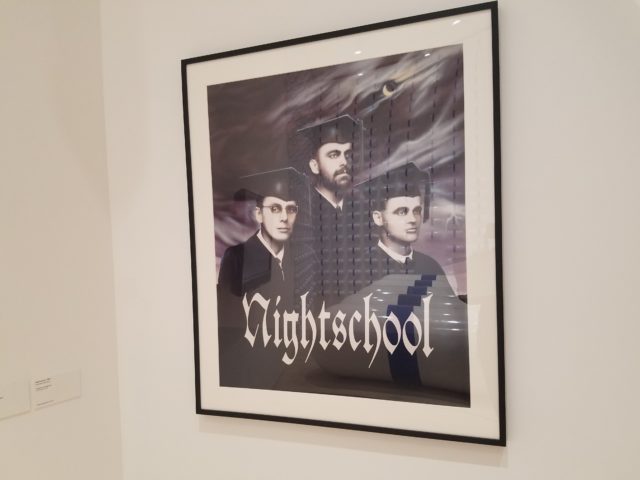
“Nightschool,” 1986.
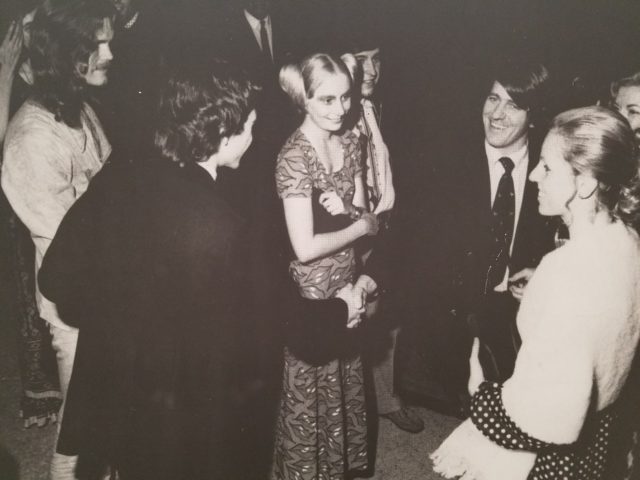
Miss Paige at The Miss General Idea Pageant in 1971, rocking Princess Leia hair years before “A New Hope” came out!

“Reconstructing Futures,” 1977.

“Jockey Short Shopping Bag,” 1991/1998.


Comments on this entry are closed.
{ 2 trackbacks }